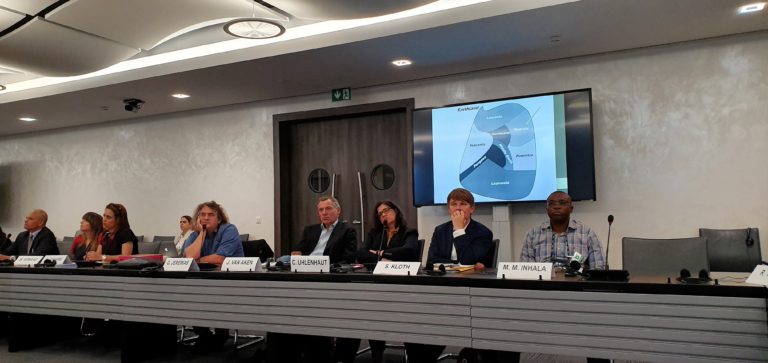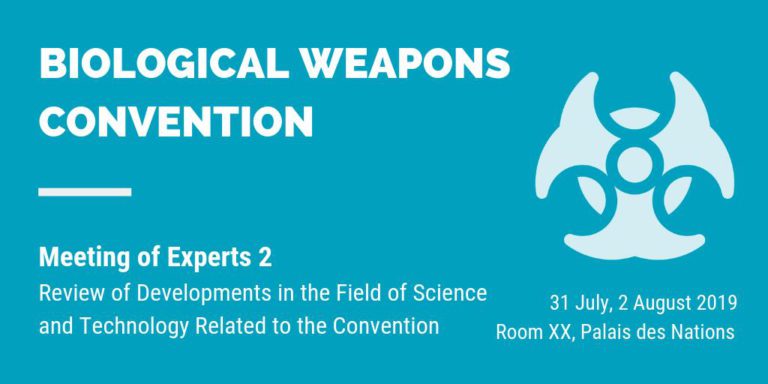Third tabletop exercise on emergency assistance in case of biological weapon use – First impressions
The day after the presentation of the report on the Article VII tabletop exercise (TTX) held in Lomé, Togo on 29 and 30 May to the states parties of the Biological and Toxin Weapons Convention (BTWC), the Fondation pour la recherche stratégique (FRS) and the BTWC Implementation Support Unit (ISU) ran another TTX in the United Nations building in Geneva. This time the focus was on a series of anthrax outbreaks that affected mostly herd animals, but also led to multiple human casualties. The scenario was a deliberate attempt to break with the habitual simulations of increasingly dire human pandemics. After all, the BTWC covers …
Blog 2 – Experiences of a student at the Meetings of Experts of the Biological and Toxin Weapons Convention
This second blog post covers both the second and third Meetings of Experts (MXs) of the Biological and Toxin Weapons Convention (BTWC). MX2 on science and technology took place on 31 July and 2 August (the day in between being the Swiss national day); MX3 on strengthening national implementation of the BTWC was a one-day event on 5 August. MX2 impressions Like at the start of the week I was still sitting behind The Trench nameplate, which was formally represented for the first time in these five MXs of 2019. MX2 was chaired by Mr Yury Nikolaichik of Belarus who decided to …
Deciding on emergency assistance in case of biological weapons use
Today, in the Palais des Nations in Geneva we presented the report on the Tabletop Exercise (TTX) on the Implementation of Article VII of the Biological and Toxin Weapons Convention (BTWC), which the Fondation pour la recherche stratégique (FRS) and the BTWC Implementation Support Unit (ISU) organised in cooperation with UN Regional Centre for Peace and Disarmament (UNREC) organised in Lomé, Togo on 28–29 May 2019. Being one of the more obscure provisions in the BTWC, Article VII only attracted state party attention over the past ten years or so. In follow-up to the decision of the 7th Review Conference (2011), parties to the convention looked for the …
How the Convergence of Science, Industry and Military Art Slaughtered Innocence
Keynote speech at the CONDENsE Conference, Ypres, Belgium, 29 August 2019 Good evening ladies and gentlemen, colleagues and friends, It is a real pleasure to be back in Ieper, Ypres, Ypern or as British Tommies in the trenches used to say over a century ago, Wipers. As the Last Post ceremony at the Menin Gate reminded us yesterday evening, this city suffered heavily during the First World War.Raised to the ground during four years of combat, including three major battles – the first one in the autumn of 1914, which halted the German advance along this stretch of the frontline …
Nuclear outrage
In its situation report of 11 March 2015, the World Health Organization (WHO) tallies a death toll of 9,961 out of 24,247 cases (41% mortality rate) in the three West-African countries of Guinea, Liberia and Sierra Leone. While the overall rate of new infections seems to be slowing down, the numbers nevertheless continue to rise. Infectious disease is the greatest threat to mankind, far higher than any imaginable terrorist plot. According to WHO statistics from about 10 years ago, infectious diseases are responsible for over 13 million deaths worldwide each year. That is 25% of all deaths worldwide each year. …
NPT Article VI and BTWC Article IX
[This contribution appeared orginally in Arms Control Law, and was in reply to a discussion on the blog. Links to the original arguments are included. – Jean Pascal] This discussion between Marco [Roscini] and Dan [Joyner] on Article VI of the NPT and customary law is instructive. In this particular case, Marco’s application of the notion to a single article rather than the totality of the treaty puzzles me. I would tend to agree with Dan’s counterpoint. However, Dan then refers to the CWC in its entirety to draw an analogy. In my mind a bit problematic for two reasons: …
On the alleged customary nature of Article VI of the NPT – A Rejoinder to Joyner and Zanders
By Marco Roscini, 5 June 2014 [Marco Roscini, Reader in International Law at the University of Westminster, wrote this rejoinder on Arms Control Law. It is reproduced here with permission, as it forms part of a broader discussion about useful insights for nuclear disarmament to be derived from chemical and biological weapon disarmament. – Jean Pascal] Both Dan and Jean-Pascal offer excellent counterarguments in their replies to my blog post on the customary nature of Article VI, and I thank them for this. After thinking carefully about their comments, I would like to offer some further thoughts. 1) I think that …
Enhancing BTWC Compliance – Workshop Report
Jean Pascal ZANDERS Senior Research Associate Fondation pour la recherche stratégique WORKSHOP REPORT Enhancing compliance of the BTWC through national implementation and other means Brussels, 24 April 2014 (PDF version) I. Participation The workshop, organised by the EU Non-Proliferation Consortium in cooperation with the European External Action Service (EEAS), was held in Brussels on 24 April 2014. Its purpose was to have an in-depth brainstorming session on the future of the Biological and Toxin Weapons Convention (BTWC) with officials from EU Member States. The event was the 1st Ad Hoc Seminar to be organised under the new Council Decision 014/129/CFSP …
Enhancing BWC Compliance – Options for the EU
The Biological and Toxin Weapons Convention (BWC) is neither in crisis nor at a cross roads, and hyperbole to the contrary is unhelpful. Yet it is perhaps because the BWC continues to trundle steadily along towards an undecided destination, that the period of relative calm should be exploited to bolster the Convention, to future proof the BWC and the norm against the hostile exploitation of infection that it embodies. To do this, there is a need for a more ambitious approach. The first two intersessional processes may have proved unexpectedly fruitful; however, this approach appears to have moved beyond its ‘best-before-date’ and …




